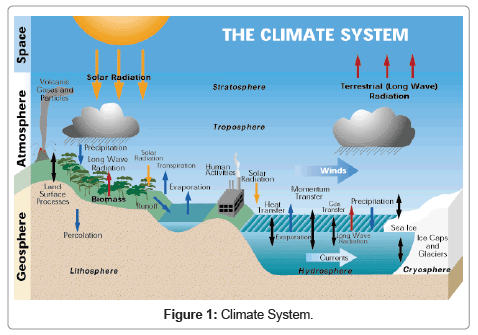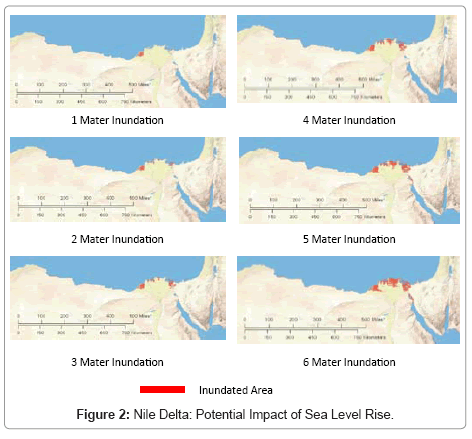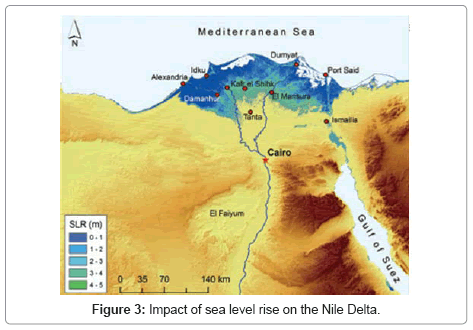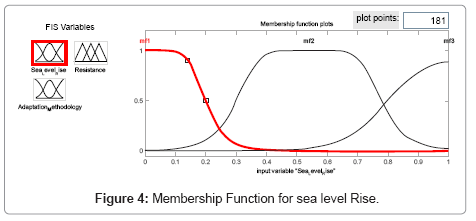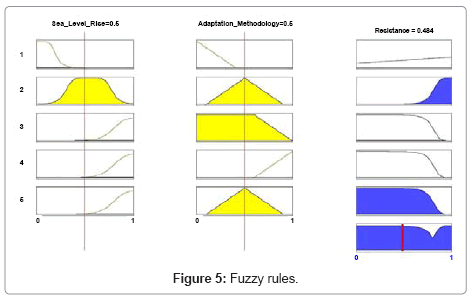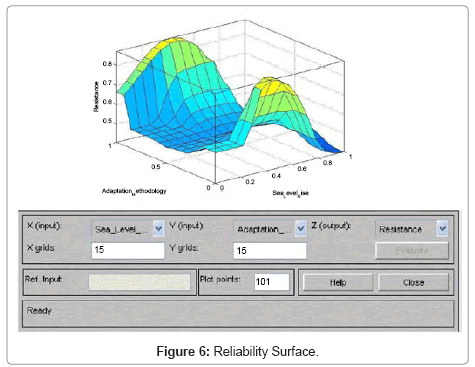Adaptation of Sea Level Rise in Nile Delta Due to Climate Change
Received: 12-Jun-2012 / Accepted Date: 20-Jul-2012 / Published Date: 23-Jul-2012 DOI: 10.4172/2157-7617.1000114
Abstract
Nile Delta is vulnerable due to the impact of climate change and related sea level rise. Due to low elevation in the Nile delta region, Egypt is considered one of the top five countries expected to be mostly impacted with a 1 m sea level rise resulting from global warming. Egypt is ranked as the fifth in the world concerning the impact on the total urban areas, Egypt’s GDP would be significantly impacted, and Egypt’s natural resources such as coastal zone, water resources, water quality, agricultural land, livestock and fisheries maybe subjected to vulnerability. Also, Egypt may face environmental crises such as shore erosion, salt-water intrusion, and soil salinity. Egypt should realize the threats from climate change, formulate policies that will minimize the risks and to take action. Adaptation to climate change in Egypt is a major issue from the perspectives of water resources development, food production, and rural population stabilization. Egypt should adapt a vulnerability index to identify the most endangered regions. A multi-criterion analysis in ranking the effectiveness of adaptation strategy using fuzzy decision making is proposed. The decision-making process involves determining the set of alternatives, evaluating alternatives, and comparison between alternatives. The model is suitable in evaluating situations that deal with ambiguity and vagueness, involve subjectivity, and imprecise information. Using fuzzy decision making technique enables maximum benefit from practical know-how, take into account several variables and perform “weighted merging” of influencing into variables.
Keywords: Adaptation; Climate change; Nile delta; Fuzzy decision making; Sea level rise; Egypt
8618Introduction
Due to low elevation in the Nile delta region, Egypt is considered one of the top five countries expected to be mostly impacted with sea level rise. Adaptation to climate change in Egypt is a major issue from the perspectives of water resources development, food production, and rural population stabilization. Egypt should identify the most endangered regions. A multi-criterion analysis in ranking the effectiveness of adaptation strategy using fuzzy decision making is proposed. The model is suitable in evaluating situations that deal with imprecise information. Using fuzzy decision making technique enables maximum benefit take into account several variables.
In Egypt, the coastal zone of the Nile Delta is subjected to the impact of climate change that may lead to sea level rise (SLR), so it is a vulnerable area especially low land areas in Alexandria, Beheira, Port-Said and Damietta governorates. In Alexandria, if sea level rise is between 0.5 m and 1.0 m over this century and if no action is taken, an area of about 30% of the city will be lost due to inundation. The adaptation measures that were identified to deal with the impact of climate change on coastal zone areas include: beach nourishment, construction of groins and breakwaters, tightening legal regulations, integrated coastal zone management and introducing changes in land use.
Climate Change Adaptation Tools
IPCC [1] defined Adaptation as initiatives and measures to reduce the vulnerability of natural and human systems against actual or expected climate change effects. Rivero Vega [2] defined as Impact Assessment as “The practice of identifying the effects of climate change at a given location. Impact assessments require a reference baseline and a projected climate change scenario”. Maladaptation–any changes in natural or human systems that inadvertently increase vulnerability to climatic stimuli; an adaptation that increases vulnerability to climate change instead of reducing it. Maladaptation can take place when the development context is not considered explicitly in designing and implementing adaptation measures. Maladaptation is also described as actions that have positive impacts on a target group or generation but, as a consequence, have adverse impacts on another group or generation [3]. Figure 1 shows Climate System.
The UN Framework Convention on Climate Change (UNFCCC) released compendium of methods and tools to evaluate impacts of, and vulnerability and adaptation to, climate change [4]. More practical perspective guides are preparing for climate change: A Guidebook for Local, Regional and State Governments [5], Climate Change Adaptation by Design [6]. Sector-specific guides such as Adapting to Coastal Climate Change: A Guidebook for Development Planners [7]. These guides are comprehensive to adaptation planning, including awareness of the complexity of vulnerability and its reduction, and understanding of what is necessary for adaptation planning. A Stocktaking Report was prepared for UNDP by Olhoff and Schaer [8] for target development organizations, practitioners and development agencies, respectively. Collections of methods and tools, such as the updated “compendium on methods and tools to evaluate impacts of, and vulnerability and adaptation to, climate change UNFCCC” [9] serve as reference documents on adaptation methods and tools. The UNFCCC provides observations on the use of methods and tools for adaptation in a background document prepared for an expert meeting [10]. It reflects not only on the aspects of methods and tools dealt with by the UNFCCC but also emphasizes key areas that need to be improved for adaptation planning, including the importance of an understanding of model limitations and increasing local level data collection.
Shift in emphasis in practitioner-focused documents from impacts to vulnerability is reflected in academic literature, where much of the ideas originated. For example, a recent study of extreme sea-level rise and public perception by Toth and Hizsnyiks [11] uses a participatory assessment approach, which reflects recognition of the importance of social aspects for determining risk. Similarly, Füssel and Klein [12] point to an increasing degree of stakeholder participation in vulnerability assessments and Van Aalst et al. [13] describe application of community risk assessment, noting that in order to keep it participatory, it needs to be simple enough for wide application. Learning process provided by adaptation planning has been highlighted as an important outcome. For example, experience of developing a municipal adaptation plan for Cape Town in South Africa led to the conclusion that making plans should be applied as a tool to educate key actors [14]. This recognizes need for awareness raising and sensitization about climate change before any planning activities can take place and reflects the important principle of ownership as a requirement for the planning process.
De Chazal et al. [15] describe a method for taking multiple stakeholders’ perspectives into account for vulnerability assessment and difficulty of dealing with conflicting values. Luers et al. [16] propose an approach for quantifying vulnerability. Qualitative descriptions of vulnerability are not always useful to plug into tools that require data to be quantified. Polsky et al. [17] provide an overview of different approaches and attempt to draw out commonalities between them in an effort to highlight the usefulness of a universal approach. Luers [18] suggests an initial analytical framework for doing this. Eakin and Bojórquez-Tapia et al. [19] offer an approach for weighting disparate factors of vulnerability. This provides a more sophisticated assessment of vulnerability, because it draws out the most important drivers, recognizing that these are different in different places. The authors base their approach on multi-criteria decision analysis and fuzzy logic. Hahn et al. [20] provide another approach to measuring vulnerability at a household level, describing the Livelihood Vulnerability Index (LVI), which they applied in Mozambique. Deressa et al. [21] provide a useful study discussing why farmers make certain choices about adaptation options. This provides further insight into what motivates people to initiate an adaptation process.
Many of tools and methods cannot be easily compared. They target different users (e.g. donors versus city governments), different levels of governance (e.g. national versus local level), different institutions (NGOs versus community leaders) and are based on different conceptual approaches to adaptation. Füssel [22] summarizes thinking about adaptation planning, he defines as being making recommendations about who should do what, more, less, or differently, and with what resources. Tyler and Fajber [23] discuss how land and water management in Asia can inform adaptation to climate change. The World Resources Institute, in National Adaptive Capacity Framework WRI [24] suggests an approach that starts by assessing the functions of the ‘adaptation system’, which includes assessment of vulnerability, impacts, adaptation practices and climate sensitivity of development activities.
Impact approach is based on understanding how climate change will affect a system or group, while vulnerability approach deals with development deficit that is causing people to be vulnerable to climate change. This diversity makes it difficult to have an overview of the methods and tools available [8]. Most assessments of the tools have focused on mainstreaming tools specifically targeted at donors [8,25,26].
Climate System is a complex interplay between atmosphere-oceansice sheets-land systems. ‘The Earth’s climate system has demonstrably changed on both global and regional scales since the pre-industrial era, with some of these changes attributable to human activities’ (IPCC‘s Third Assessment Report, 2001). Tools of climate change science are data on temperature, precipitation, humidity, wind and air pressure, solar irradiance, then understanding the systems that control and drive climate using general circulation models-NCAR (USA), Hadley Centre (UK).
Current Sea Level Rise
This potentially impacts human populations (e.g., those living in coastal regions and on islands) and wider natural environment (e.g., marine ecosystems) [3]. Global average sea level rose at an average rate of around 1.8 mm per year over 1961 to 2003 and at an average rate of about 3.1 mm per year from 1993 to 2003 [4]. It is unclear whether or not the increased rate observed between 1993 and 2003 reflects an increase in the underlying long-term trend.
Nile Delta Study
With just a one-meter rise in the Mediterranean Sea, the Nile Delta stands to suffer tremendously. Rising seas would destroy parts of the protective offshore sand belt, which has already been weakened by reduced sediment flows resulting from the construction of the Aswan High Dam in 1970. Figure 2 shows potential impact of sea level rise in Nile Delta.
Without this sand belt, water quality in coastal freshwater lagoons will be altered (threatening one-third of Egypt’s fisheries), groundwater will be salinated, and recreational tourism and beach facilities will be inundated. It is predicted that 6.1 million people will be displaced and 4,500 square kilometers of cropland will be lost. Estimated impact on Gross Domestic Product (GDP) exceeds six percent for a one-meter rise and 16 percent for five-meters (World Bank, 2007) (Figure 3).
Vulnerability and Adaptation
For countries such as Egypt, developing adaptation strategies to deal with impending climate change will be vital. In the coastal city of Alexandria, Egypt, for example, authorities are spending US$300 million to construct concrete sea walls to protect beaches from rising seas. Egyptian ministry of environmental affairs is also preparing a “national strategy study” on adaptation, including a vulnerability index to pinpoint the most endangered regions. Given a number between 0 and 10 that represents the intensity of resistance at a site (where 10 is excellent), what should the adaptation be.
Vulnerability Index
A vulnerability index is a composite of indices, also referred to as integrated indices, which are quantitative indicators similar to scales, which, when entered into a formula, deliver a single numerical result which can be used for triage (prioritization) and policy analysis. Through their use, “diverse issues can be combined into a standardized framework…making comparisons possible” [27]. For instance, variable from physical science can be combined with social, medical and even psychological variables to evaluate potential complications in disaster planning contexts. The development of vulnerability indexes as a policy planning tool occurred at the instance of the United Nations Environmental Program and one of the participants in the early task forces has also conducted secondary research documenting the evolution of the analytic tool through various stages [28].
Vulnerability Indicators
Indicators are a way of quantifying the level of vulnerability. An indicator is a single measure of a characteristic where an index is a composite measure of several indicators or indices. Indicators need to reflect an explicit conceptual framework of vulnerability. Many scientists are very cautious about the use of indicators [29]. Indicators and indexes can be useful to guide decision-making and prioritize intervention, as they allow characteristics to be compared. The use of indicators has been one of the most widely proposed approaches, which has been primarily applied to adaptive capacity [30-33], as well as to vulnerability [16,34]. The development of indicators can be seen as a way to identify proxies for adaptation. Indexes of vulnerability should be treated with caution, precisely because of complex nature of vulnerability that results in many factors being at play and the difficulty in capturing diversity and sensitivity of vulnerability.
Fuzzy Decision Making
Fuzzy Decision Making employs fuzzy technologies to obtain optimal solutions and support in making the best possible decisions. Fuzzy Decision Making provides advancing practice in the presence of uncertainty. In this contribution, the goal is to help foster the understanding, development, and practice of fuzzy technologies for solving Nile Delta resilience due to climate change problems.
Fuzzy Logic Approach
Fuzzy logic is a form of knowledge representation suitable for notions that cannot be defined precisely, but which depend upon their contexts. Fuzzy logic provides a method to formalize reasoning when dealing with vague terms. Fuzzy logic provides an alternative way to represent linguistic and subjective attributes of the real world in computing. Traditional computing requires finite precision which is not always possible in real world scenarios. Not every decision is either true or false, or as with Boolean logic either 0 or 1. Fuzzy logic allows for membership functions, or degrees of truthfulness and falsehoods. Or as with Boolean logic, not only 0 and 1 but all the numbers that fall in between.
Membership Function
A fuzzy set is defined by its “membership function” which corresponds to the notion of a “characteristic function” in classical logic. Let us assume that we want to define the set of people of “medium height”. In classical logic, we would agree for example that people of medium height are those between 1.60 m and 1.80 m tall. The characteristic function of the set gives “0” for heights outside the range [1.60 m; 1.80 m] and “1” for heights in that range. The fuzzy set of people of “medium height” will be defined by a “membership function” which differs from a characteristic function in that it can assume any value in the range [0; 1]. Each possible height will be assigned a “degree of membership” to the fuzzy set of “medium heights” between 0 and 1. Figure 4 presents Membership Function for sea level Rise. A fuzzy set is defined by a membership function, mapping objects in a universe U to a membership value:
S: U →[0, 1]
Fuzzy Rules
The purpose of fuzzy rule bases is to formalize and implement a human being’s method of reasoning. The tool most commonly used in fuzzy logic applications is the fuzzy rule base. A fuzzy rule base is made of rules which are normally used in parallel but which can also be concatenated in some applications.
A rule is of the type: IF “predicate” THEN “conclusion”. For example: IF “high temperature and high pressure” THEN “strong ventilation and wide open valve”. We need to capture the essentials of this problem, leaving aside all the factors that could be arbitrary. If you make a list of what really matters in this problem, you might end up with the following rule descriptions.
Intensity of Resistance Problem Rules-adaptation Factor
If adaptation is bad, then Resistance is defective
If adaptation is average, then Resistance is standard
If adaptation is good, then Resistance is high-quality
The order in which the rules are presented here is arbitrary. It does not matter which rules come first. If you want to include the Sea Level Rise’s effect on the intensity of resistance, add the following three rules.
Intensity of Resistance Problem Rules-Sea Level Rise Factor
If Sea Level Rise is low, then Resistance is high-quality
If Sea Level Rise is average, then Resistance is standard
If Sea Level Rise is high, then Resistance is defective
You can combine the two different lists of rules into one tight list of three rules like so.
Intensity of Resistance Problem Rules-adaptation Factor
If adaptation is bad and Sea Level Rise is high, then Resistance is defective
If adaptation is average and Sea Level Rise is average, then Resistance is standard
If adaptation is good and Sea Level Rise is low, then Resistance is high-quality
These three rules are the core of the solution. Figure 5 shows Fuzzy rules. After the rules for a fuzzy logic system have been defined, then we should give mathematical meaning to the linguistic variables (what is an average resistance, for example?).
Now, we can build a complete fuzzy inference system. The methodology of fuzzy logic must also consider:
• How the rules all are combined?
• How do I define mathematically what the standard intensity of resistance is?
The view of surface lets you examine the output surface of a FIS stored in a file, for any inputs. Because it does not alter the fuzzy system or its associated FIS structure in any way, we select the two input variables sea level rise and adaptation and assign to the two input axes (sea level rise X and adaptation Y), as well the output variable that assign to the output (intensity of resistance or Z) axis. Figure 6 shows reliability surface.
Conclusion
A decision model for evaluating the intensity of resistance (reliability) strategies based on fuzzy logic theory has been proposed. The model is exemplified by simple criteria comprising: sea level rise and adaptation. Modification of the model to cover other criteria such as desertification, water resources availability and cost can be easily incorporated. The model can be used by decision-makers to choose the most appropriate reliability strategy. The model emphasizes the multicriterion aspect of climate change evaluation, the qualitative, subjective, and non interactive nature of these criteria, and their aggregation in the evaluation process. It should be emphasized that non-interactivity is one of the important features that underline the fuzzy aggregation procedure. Non-interactivity simply means the ratings assigned to major criteria such as sea level rise and adaptation does not compensate each other. It has been noted that the proposed procedure using fuzzy sets is just an addition to the range of multicriterion decision methodologies. The particular characteristic of the present procedure is its emphasis on the human perception nature, the qualitative or subjective criteria used in reliability, and the theoretical basis for aggregation of these criteria.
References
- IPCC (2007) Fourth Assessment Report. Intergovernmental Panel on Climate Change, Cambridge University Press: Cambridge.
- Rivero Vega RE (2008) Workbook on Climate Change Impact Assessment in Agriculture: Basic Knowledge, Methodologies and Tools. Caribbean Community Climate Change Centre and the Cuban Institute of Meteorology.
- Barnett J, O’Neill S (2010) Maladaptation. Global Environmental Change 20: 211-213.
- UNFCCC (2004) Compendium of Methods and Tools to Evaluate Impacts of, and Vulnerability and Adaptation to, Climate Change. UNFCCC: Bonn, Germany.
- ICLEI (2007) Preparing for Climate Change: A Guidebook for Local, Regional and State Governments’. International Council for Local Environmental Initiatives, Center for Science in the Earth System, University of Washington, King County, US.
- Shaw R, Colley M, Connell R (2007) Climate Change Adaptation by Design: a Guide for Sustainable Communities. TCPA: London.
- USAID (2009) Adapting to Coastal Climate Change: A Guidebook for Development Planners, USAID: Washington DC, United States.
- Olhoff A, Schaer C (2009) Screening Tools and Guidelines to Support the Mainstreaming of Climate Change Adaptation into Development Assistance-A Stocktaking Report. Prepared for UNDP: New York.
- UNFCCC (2008a) ‘Compendium on Methods and Tools to Evaluate Impacts of, and Vulnerability and Adaptation to, Climate Change’. UNFCCC: Bonn, Germany.
- UNFCCC (2008b) Baseline Paper for the Expert Meeting on Methods and Tools and on Data and Observations under the Nairobi Work Programme on Impacts, Vulnerability and Adaptation to Climate Change, Mexico City, 4-7 February 2008. UNFCCC: Bonn, Germany.
- Toth FL, Hizsnyiks E (2008) Managing the Inconceivable: Participatory Assessments of Impacts and Responses to Extreme Climate Change. Climatic Change 91: 81-101.
- Füssel HM, Klein RJT (2006) Climate Change Vulnerability Assessments: An Evolution of Conceptual Thinking. Climatic Change 75: 301-329.
- Van Aalst MK, Cannon T, Burton I (2008) Community Level Adaptation to Climate Change: the Potential Role of Participatory Community Risk Assessment. Global Environmental Change 18: 165-179.
- Mukheibir P, Ziervogel G (2007) Developing a Municipal Adaptation Plan (MAP) for Climate Change: the City of Cape Town. Environment & Urbanization 19: 143-158.
- De Chazal J, Quétier F, Lavorel S, Van Doorn A (2008) Including multiple differing stakeholder values into vulnerability assessments of socio-ecological systems. Global Environmental Change 18: 508-520.
- Luers AL, Lobell DB, Sklar LS, Addams CL, Matson PA (2004) A method for quantifying vulnerability, applied to the agricultural system of the Yaqui Valley Mexico. Global Environmental Change 13: 255-267.
- Polsky C, Neff R, Yarnal B (2007) Building comparable global change vulnerability assessments: The vulnerability scoping diagram. Global Environmental Change 17: 472-485.
- Luers AL (2005) The Surface of Vulnerability: An Analytical Framework for Examining Environmental Change. Global Environmental Change 15: 214-223.
- Eakin H, Bojórquez-Tapia LA (2007) Insights into the composition of household vulnerability from multicriteria decision analysis. Global Environmental Change 18: 112-127.
- Hahn MB, Riederer AM, Foster SO (2008) The Livelihood Vulnerability Index: A Pragmatic Approach to Assessing Risks from Climate Variability and Change-A Case Study in Mozambique. Global Environmental Change 19: 74-88.
- Deressa TT, Hassan RH, Ringler C, Alemu T, Yesuf M (2009) ‘Determinants of farmers’ choice of adaptation methods to climate change in the Nile Basin of Ethiopia. Global Environmental Change 19: 248-255.
- Füssel HM (2007) Vulnerability: A Generally Applicable Conceptual Framework for Climate Change Research. Global Environmental Change 17: 155-167.
- Tyler S, Fajber L (2009) Land and Water Resource Management in Asia: Challenges for Climate Adaptation. International Institute for Sustainable Development (IISD): Canada.
- WRI (2009) National Adaptive Capacity Framework. World Resources Institute: Washington DC, United States.
- Klein RJT, Eriksen SEH, Naess LO, Hammill A, Tanner TM, et al. (2007) Portfolio screening to support the mainstreaming of adaptation to climate change into development assistance. Climatic change 48: 23-44.
- Kropp J, Scholze M (2009) Climate Change Information for Effective Adaptation. GTZ: Eschborn.
- Fischlin A (2007) Section 4.4.9: Oceans and shallow seas-Impacts. Chapter 4: Ecosystems, their Properties, Goods and Services 234.
- Barnett J, Lambert S, Fry I (2008) The hazards of indicators: insights from the environmental vulnerability index. Ann Assoc Am Geogr 98: 102-119.
- Eriksen SH, Kelly PM (2007) Developing credible vulnerability indicators for climate adaptation policy assessment. Mitigation and Adaptation Strategies for Global Change 12: 495-524.
- Brooks N, Adger WN, Kelly PM (2005) The determinants of vulnerability and adaptive capacity at the national level and the implications for adaptation. Global Environmental Change 15: 151-163.
- Lioubimtseva E, Henebry GM (2009) Climate and environmental change in arid Central Asia: Impacts, vulnerability, and adaptations. J Arid Environ 73: 963-977.
- Swanson D, Hiley J, Venema HD, Grosshans R (2007) Indicators of Adaptive Capacity to Climate Change for Agriculture in the Prairie Region of Canada. International Institute for Sustainable Development, Winnipeg, Canada.
- Cutter SL, Barnes L, Berry M, Burton C, Evans E, et al. (2008) ‘A place-based model for understanding community resilience to natural disasters. Global Environmental Change 18: 598-606.
Citation: Batisha AF (2012) Adaptation of Sea Level Rise in Nile Delta Due to Climate Change. J Earth Sci Climate Change 3: 114. DOI: 10.4172/2157-7617.1000114
Copyright: ©2012 Batisha AF. This is an open-access article distributed under the terms of the Creative Commons Attribution License, which permits unrestricted use, distribution, and reproduction in any medium, provided the original author and source are credited.
Share This Article
Recommended Journals
Open Access Journals
Article Tools
Article Usage
- Total views: 21356
- [From(publication date): 7-2012 - Apr 03, 2025]
- Breakdown by view type
- HTML page views: 16146
- PDF downloads: 5210

